CALIFORNIA
History

History

Cities in CALIFORNIA
| Los angeles | San francisco |
Popular destinations USA
| Arizona | California | Florida |
| Hawaii | Utah |
History
California before the arrival of the Europeans
For thousands of years before the arrival of the Europeans, many Indian tribes lived in what is now referred to as California. Archaeological finds indicate that at least 13,000 BC. people lived in the western United States. California had an estimated 300,000 inhabitants at the time of the arrival of the Europeans.
The Indians lived in small villages along the coast, in the woods and in the desert. Not much is known about these tribes, there are hardly any important archaeological finds, written sources and large buildings as with the Incas and Aztecs certainly not. What remains are carved shells, arrowheads and some petroglyphs, other others from the Chumash tribe.
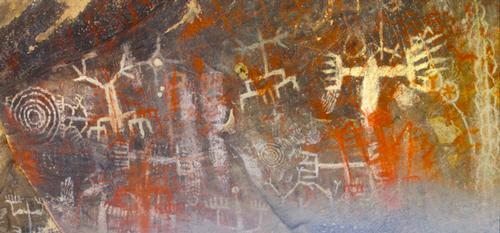 Chumash Petroglyphs, Simi Valley, CaliforniaPhoto: Niceley CC 4.0 Internationalno changes made
Chumash Petroglyphs, Simi Valley, CaliforniaPhoto: Niceley CC 4.0 Internationalno changes made
Europeans discover California
The first Europeans to set foot on California soil were Spanish explorers. They were looking to expand their colony of New Spain which, under the Treaty of Tordesillas (1494), included the area west of Brazil and all of North America west of the Rocky Mountains.
In 1535, Spanish explorer Hernán Cortés (1485-1547), conqueror of Mexico and destroyer of the Aztec Empire, thought he had discovered a short sea route to Asia, but in fact landed on the southernmost tip of today's Baja California peninsula and called it Santa Cruz.
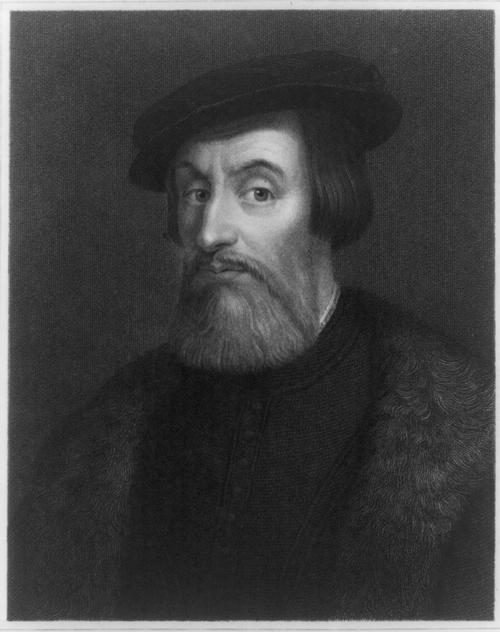
The first explorer to use the name California for the first time and actually enter the American state was Juan Rodríguez Cabrillo or João Rodrigues Cabrilho (± 1499-1543), a Portuguese in Spanish service. He discovered San Diego Bay in 1542 and sailed on to the Channel Islands off the coast of Santa Barbara. Only fifty years later, in 1592, the Greek Juan de Fuca (actual name Ioánnis Fokás, 1536-1602), like Cabrillo in Spanish service, ventured the dangerous journey.
Meanwhile, the English were also active in the waters off the West American coast. In 1579, the explorer Sir Francis Drake (± 1540-1596) landed on what is now Drake's Bay just north of San Francisco. He took possession of all the land of the indigenous Miwok Indians and named the area Nova Albion, New England.
The most thorough voyage of discovery along the West American coast was carried out in 1602 by the Spaniard Sebastián Vizcaíno (± 1548-1624) and was the namesake of many places now known under the same name. One such name and place, a hundred miles south of San Francisco, is Monterey. This place was to be the military and administrative center of the Spanish colony for a period of 75 years. It also housed the headquarters of the Franciscan missions that were founded all over California between 1769 and 1823.
Colonization: Spaniards and Russians
The definitive colonization of California didn't really begin until 1769 with a combination of military necessity to keep other nations out, and religious intent to convert the Native Americans. An army of about three hundred soldiers left together with the Spanish Franciscan missionary Junípero Serra (1713-1784), partly by land and by sea to 'Las Indias', as the Spaniards often called their new colony. There was also an overland expedition by the Spanish military and explorer Gaspar de Portolá Rovira (1716-1786).
 Junípero Serra, missionary in CaliforniaPhoto: Public domain
Junípero Serra, missionary in CaliforniaPhoto: Public domain
In June 1770, after a small mission post and fort had already been established by Serra in San Diego, a second expedition arrived in Monterey, and a mission post and a small fort were built there too. From 1777, the first villages (pueblos) were also founded, intended to attract settlers. The first 'pueblo' was San Jose, succeeded by Los Angeles in 1781. The pueblos did not yet represent many, until the 19th century such villages did not have much more than a hundred inhabitants.
The military presence, according to the Spaniards, although the two nations were friendly with each other, was to deter the Russians, who owned a small colony in Alaska with mostly trappers. The Russians were not deterred, however, as they knew that the Spaniards had great difficulty in maintaining their food supplies, ammunition and gunpowder. It didn't take long before the Russian outpost Fort Ross (now: Sonoma County coast) was built in 1812, less than a hundred kilometers north of San Francisco. This undermined the Spaniards' authority over this region, although the Russians left as early as 1841.
Mexico
While Spain, France and England were embroiled in the Napoleonic Wars, the colonies of New Spain rebelled against European powers, leading to Mexico's independence in 1821. The Mexican Republic, or as it was called the United States of Mexico, ruled Upper California at the time. Upper California (Spanish: Alta California) at that time consisted of the present-day states of California, Nevada, Utah and parts of Arizona, Wyoming, Colorado and New Mexico.
During Spanish and Mexican rule it was forbidden for 'foreigners' to settle in California. It was not until the 1920s that the first 'Americans', initially only men, came to California and assimilated into existing Mexican culture by marrying into Mexican families and transitioning to the Roman Catholic faith. Slowly but surely there was a constant stream of emigrants, now also many women. In those first decades ships sailed via Cape Horn to the west coast of America in three months. The first people to make the four-month journey over land in covered wagons arrived in 1841. Due to the dangerous journey and the difficult circumstances, the immigration of American settlers started with difficulty, in 1846 there were only about 7,000 people left the region, including all Spaniards and Mexicans, excluding Indians.
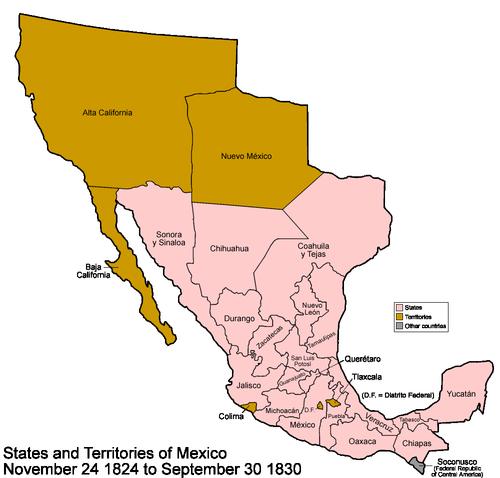 Mexico at the beginning of the 19th century, with Alta California to the northwestPhoto: Golbez CC 3.0 Unportedno changes made
Mexico at the beginning of the 19th century, with Alta California to the northwestPhoto: Golbez CC 3.0 Unportedno changes made
From the 1930s onwards, the United States was committed to colonizing the continent from coast to coast. As for California, the Mexicans were unsuccessfully offered to buy the area north of the Rio Grande, the current border between the United States and Mexico. In April 1846, President James Polk made a $ 40 million offer for New Mexico and present-day California, while simultaneously annexing the independent Republic of Texas, which was also claimed by Mexico. Not long after this, the Mexican-American War broke out. The war in this war took place entirely on Texan territory, except for a battle at San Pasqual, a town northeast of San Diego. There, pro-Mexican Californios were defeated and Monterey, the region's capital, was captured by the US Navy without firing a shot. In January 1847 the Californios surrendered completely and at that time the Americans controlled the entire west coast. It is worth mentioning that just before the outbreak of the war California had its own government by proclaiming the so-called 'Bear Flag Republic'. In June 1846 American colonists declared California independent, but this status lasted only a short time, three weeks later American troops took over command again.
California 31st state of the United States of America
The Mexican-American War was formally ended on February 2, 1848, during the Peace of Guedelupe Hidalgo, which sold Alta California to the United States for $ 15 million. The mexicans who suddenly lived in the United States because of the border marker, were allowed to choose between Mexican or American nationality. most Mexicans chose the American nationality.
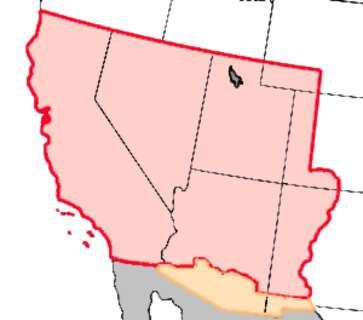 US territory after the Peace of Guadelupe HidalgoPhoto: Matthew Trump / GFDL CC BY-SA 3.0 no changes made
US territory after the Peace of Guadelupe HidalgoPhoto: Matthew Trump / GFDL CC BY-SA 3.0 no changes made
A few days before the signing of the Peace of Guedelupe, on January 24, 1848, James Wilson Marshall (1810-1885) found gold in the waters of the American River in the waters of the American River, near Sacramento, near the town of Coloma, near Sacramento. Gold Rush underway. From the middle of the year 1849, thousands of prospectors traveled from east to west through the United States and many finds were made especially in those early years of the Goldrush. However, within fifteen years the hype was over, much gold was no longer found.
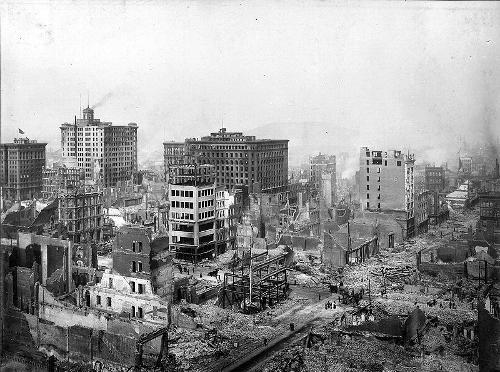
At the end of 1849, a constitutional convention was organized in Monterey, deciding, among other things, the eastern border of California and banning slavery. The drafting of a constitution was necessary to be able to join the United States of America: on September 9, 1850, the time had come, California became the 31st state of the United States. The first governor of California was Peter Hardeman Burnett (1807-1895), who remained in office from December 20, 1849, before California was officially a state of the United States, until January 9, 1851. Sacramento was declared the capital of the state of California in 1854.
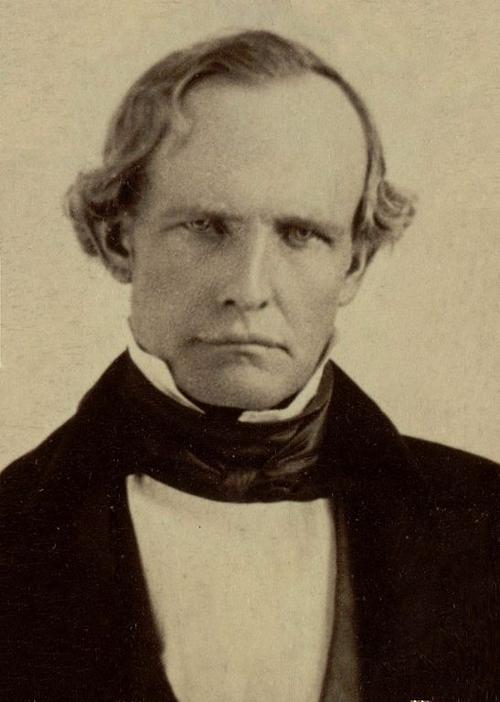 Peter Hardeman Burnett, First California GovernorPhoto: unknown in the public domain
Peter Hardeman Burnett, First California GovernorPhoto: unknown in the public domain
Although California was not very "troubled" by the American Civil War (1861-1865), many bloody battles were fought between white settlers and Indian tribes on California territory. At first they tried to irrigate the insians reserves, but due to the continuous large-scale colonization of the soil, the Indians were increasingly pushed back to small pieces of land. In the end, the Indians did not accept this, resulting in a lot of violence. As a result of this and a combination of (Western) diseases and famine, the number of Indians declined sharply and by 1870 more than 90% of all Indians had been exterminated. The descendants of the survivors still live in small, poorly equipped servants: Cahuilla near Palm Springs, Paiute / Shoshone in the Owens Valley, and the Hupa on the northwest coast. After the gold rush, the number of California residents exploded, partly due to the completion of a transnational railroad across America that took five days instead of a month to travel from the east to the west of the United States; the population of San Francisco rose from 500 to 50,000 in five years.
In the early morning of April 18, 1906, the Great Earthquake, 7.8 on the Richter Scale, took place in San Francisco, causing more than 3,000 people to die from the earthquake, but most of all from the fires that broke out everywhere, leaving more than 300,000 homeless ; 28,000 buildings were destroyed. Despite this disaster, the city was quickly rebuilt and California continued to grow, partly due to the rise of the film industry in the Hollywood neighborhood of Los Angeles in 1911.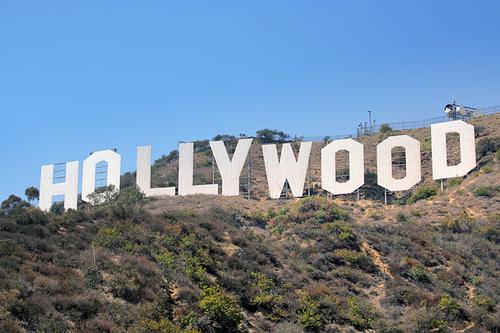 Hollywood, California, center of the movie industryPhoto: Sörn CC 2.0 Genericno changes made
Hollywood, California, center of the movie industryPhoto: Sörn CC 2.0 Genericno changes made
This growth was caused by the outbreak of the Great Depression in 1929, when thousands of people from, among others, the Dust Bowl, central states of the United States, came to California in search of work.
This dire situation turned for the better in World War II, when heavy industries settled in California for the production of war material. Between 1942 and 1945, approximately 10,000 Japanese men, women and children, American citizens, were put in a number of internment camps in reprisal for the Japanese attack on Pearl Harbor. In the Owens Valley, in southeastern California, there were ten camps alone, including Camp Manzanar. After the war, many soldiers who had fought in the South Pacific settled in California. It was easy for the veterans to find work and the large-scale approach to infrastructure in the United States created large commuter cities.
The 1950s brought much prosperity to middle-class Americans and San Francisco in particular became a center for writers and artists, attracting many intellectuals to form the Beat generation. Between 1941 and 1962, California's population exploded from 9 million to 22 million, a growth that continued afterward.
Throughout the 1960s and 1970s, California continued to be a center of youth and social turmoil in the flower-power era. The drug LSD was introduced and peaked in 1967 during the Summer of Love, when almost all of San Francisco appeared to be populated by barefoot and drugged "flower children."
The flower-power era came to an end with the protests against the Vietnam War, which continued to be rife in California until the 1970s, particularly on the campus of the University of California at Berkeley. The 'innocence' of the 1960s came to an end with the assassinations of youth popular human rights activist Martin Luther King Jr. and presidential candidate Bobby Kennedy, who was murdered in Los Angeles. The radical Black Panther movement from Oakland and the massacres of Charles Manson and the violent Symbionese Liberation Army (SLA) also contributed to a hardening of society. Governors in the 1970s were the later president Ronald Reagan (1911-2004) and Jerry Brown (1938-), who introduced the most stringent environmental measures in the world and strongly focused on the use of alternative energy sources. In 1989, the Loma Prieta earthquake hit the Bay Area, which was hit again a few years later by a massive fire in Oakland Hills that killed 24 people.
In addition to floods, large fires (including Malibu) and mudslides, an earthquake of 6.7 on the Richter Scale in the San Fernando Valley in 1994 killed 57 people. The 1990s also saw two high profile lawsuits: black motorcyclist Rodney King was beaten to death by police officers, all of whom were subsequently acquitted; the famous ex-football player O.J. Simpson was acquitted of the murders of his ex-wife and her boyfriend. The acquittal of the Rodney King agents sparked some of the worst racial conflict in California history, with more than 50 dead, more than 2,500 injured, and thousands of fires.
Economically important was the rise of Silicon Valley, an area on the south side of San Francisco Bay, where many high-tech companies have established their headquarters over the past few decades, including Apple, Intel, eBay, Google and Facebook.
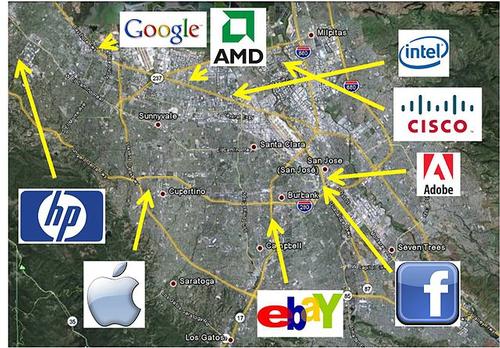 Overview of Silicon Valley, California companiesPhoto: Samykolon CC 3.0 Unportedno changes made
Overview of Silicon Valley, California companiesPhoto: Samykolon CC 3.0 Unportedno changes made
California in the 21st Century
With a gross domestic product of $ 1.74 billion in 2013, about two-thirds of the entire United Kingdom, California has one of the largest economies in the world.
On August 17, 2013, a campfire in Yosemite National Park started California's fourth-largest fire. The fire was only completely under control after four weeks; 100,000 hectares were destroyed.
In February 2017, California, especially the central and southern parts of the state, suffered severe storms and heavy rainfall. According to meteorologists, it was the heaviest storm since 1995. A state of emergency was declared in San Jose and more than a thousand homes were evacuated. Entire neighborhoods were covered with a layer of muddy water.
See also chapter history of the USA.
Sources
BBC - Country Profiles
Benson, Sara / California
Lonely Planet
Benson, Sara / Discover California
Lonely Planet
Californië
Uitgeverij Cambium B.V.
CIA - World Factbook
Elmar Landeninformatie
Hansen, Preben / 100% Californië & West-USA
Mo'Media
Heetvelt, Angela / Zuidwestelijke staten van Amerika
Gottmer/Becht
Mangin, Daniel / Californië : de reisgids voor een actieve & culturele vakantie
Wat & Hoe
Ominalowska, Malgorzata / Californië
Uitgeverij Unieboek/Het Spectrum
The Rough Guide to California
Rough Guides Ltd.
Schmidt-Brümmer, Horst / Lannoo's autoboek Californië en Zuidwest-USA : on the road
Lannoo
Vlahides, John A. / Northern California
Lonely Planet
Wikipedia
Zuidwest-USA
Uitgeverij Terra Lannoo
Copyright: Team The World of Info